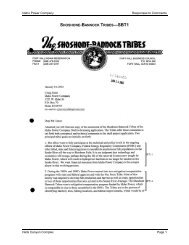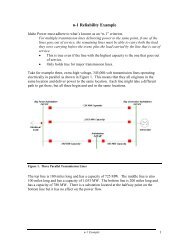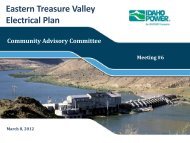Snake River White Sturgeon Conservation Plan ... - Idaho Power
Snake River White Sturgeon Conservation Plan ... - Idaho Power
Snake River White Sturgeon Conservation Plan ... - Idaho Power
Create successful ePaper yourself
Turn your PDF publications into a flip-book with our unique Google optimized e-Paper software.
<strong>Idaho</strong> <strong>Power</strong> CompanyChapter 4: Conceptual Design for <strong>White</strong> <strong>Sturgeon</strong> Passage Facilitiesforebay elevation rises 48 ft above the minimum elevation of the forebay, the ladder is shutdown. Capital costs for this ladder were estimated at $22,400,000, with an O&M cost of$672,000 (Harza Northwest, Inc. 1999).Typical fish ladders cost between $100,000 and $200,000 per foot of rise. For sturgeon passage,the typical design would have to be modified to account for fish size and characteristics.Accommodating sturgeon could require a larger fish ladder with additional resting pools and amore gradual incline. The costs for such a ladder would run in the upper part of the cost range, ifnot higher. To account for their larger size, we have assumed that the ladders would need to betwice as long for sturgeon as for anadromous fish. Therefore, ladder length would be based on a1-ft vertical rise for every 20-ft horizontal run.4.2.2. Fish Locks4.2.2.1. DescriptionAlthough experimental fish locks were tried as early as the 1920s, they were not developed into apractical method for passing fish until the late 1940s. The first of these modern locks wasdesigned by J. H. T. Borland and constructed in Ireland. Subsequent installations have beenreferred to as Borland Locks.A typical Borland lock (Figure 9) consists of a top and bottom chamber connected by a slopingchamber. A certain amount of flow is released through the top gate and flows down the slopingchamber into the bottom chamber. This flow empties into the tailrace and attracts fish that aremigrating upstream. At a predetermined time in a cycle or when sufficient fish have entered thebottom chamber, the downstream gate is closed, the upstream gate is opened, and the lock fillswith water. The fish then swim up the shaft and into the forebay. Then the gates are adjusted, thelock is drained, and the process is repeated. Borland locks have been designed for dams as highas 200 ft (such as Orrin Dam in Scotland). To date, most fish locks are in Europe, although a fewhave been built in the United States. The primary functional disadvantage of the Borland lockshas been the inability to clear all fish from the vertical shaft in a timely manner. Locks also havea much smaller capacity than ladders and lifts (Clay 1995).Most of the Borland-type locks are constructed for passing salmon on smaller rivers in Europe.The Bonneville Dam was constructed with three pair of fish locks that were operated from1938 to 1969 (Figure 10). These locks have the added refinement of a grated floor, which wasraised to force the captured fish into the forebay. The locks were observed by a Russian fisheriesscientist in 1946 and used as a prototype for several fish locks in Russia. Fish locks were alsoused at McNary Dam during construction and at The Dalles Dam. Neither of these locks iscurrently in use.In Russia, fish locks are designed to pass sturgeon and other species and have features that werenot included in the earlier Borland and Bonneville locks. The Tzymlyanskij fish lock on theDon <strong>River</strong> was designed with a vertical shaft. It provides auxiliary water attraction, a fishcrowder to direct the fish into the lock, and a vertical crowder or lifting basket to ensure that thefish ascend the lock into the forebay (Figure 11). The Volzhskaya Dam on the Volkhov <strong>River</strong>and the Volgogradskiy Dam on the Volga <strong>River</strong> are similarly designed, except that both haveHells Canyon Complex Page 17

















